EMN 2008-2009 Overview - Réseau Européen de la Microfinance
EMN 2008-2009 Overview - Réseau Européen de la Microfinance
EMN 2008-2009 Overview - Réseau Européen de la Microfinance
Create successful ePaper yourself
Turn your PDF publications into a flip-book with our unique Google optimized e-Paper software.
25%<br />
20%<br />
15%<br />
10%<br />
5%<br />
0%<br />
Eighty percent of respon<strong>de</strong>nts indicated<br />
that they offer grace periods of varying<br />
lengths. The mean grace period is 6 months,<br />
the maximum is 24 months and the minimum<br />
is 1 month, exactly the same as seen in the<br />
previous survey.<br />
5.2 Interest Rates<br />
One hundred and thirty two institutions<br />
respon<strong>de</strong>d to this question. The average<br />
interest rate charged across survey<br />
respon<strong>de</strong>nts is 9%, one percentage point<br />
above the average of the previous survey.<br />
Graph 26: Average interest rate by country<br />
22,2%<br />
uK<br />
17,0%<br />
Po<strong>la</strong>nd<br />
16,9%<br />
Romania<br />
14,3%<br />
Bulgaria<br />
11,0%<br />
Croatia<br />
9,0%<br />
Ire<strong>la</strong>nd<br />
8,6%<br />
Spain<br />
8,3%<br />
Nether<strong>la</strong>nds<br />
7,8%<br />
Hungary<br />
7,0%<br />
estonia<br />
Interest rates are re<strong>la</strong>ted to the existence<br />
of usury <strong>la</strong>ws. At the present time, nearly<br />
all EU countries have usury rates or rate<br />
ceilings in or<strong>de</strong>r to protect consumers<br />
against over-in<strong>de</strong>btedness and predatory<br />
lending practices. Only two countries have<br />
a specific <strong>la</strong>w regarding the regu<strong>la</strong>tion of the<br />
microfinance sector, France and Romania<br />
(European Commission, 2007a). Where usury<br />
<strong>la</strong>ws are in p<strong>la</strong>ce, len<strong>de</strong>rs must not charge<br />
above these stated maximums. Interest caps,<br />
when not too low, enable len<strong>de</strong>rs to establish<br />
an a<strong>de</strong>quate interest rate that covers their<br />
operational and financial costs. In the UK and<br />
Romania, however, which do not have these<br />
types of restrictions, we find higher average<br />
interest rates. In fact, amongst UK len<strong>de</strong>rs<br />
participating in survey, the maximum interest<br />
6,7%<br />
Swe<strong>de</strong>n<br />
Graph 26 shows the average interest rate by<br />
country. The highest interest rate charged<br />
is 22.2% in the United Kingdom and the<br />
lowest interest rate charged is 2% in Fin<strong>la</strong>nd.<br />
As a reference, at the time of the survey, the<br />
average Euribor rate in <strong>2009</strong> was 5%. We<br />
continue to find that there is a re<strong>la</strong>tionship<br />
between high interest rates and the mission<br />
statements and legal status of the len<strong>de</strong>rs. In<br />
Eastern EU countries (Romania, Bulgaria and<br />
Po<strong>la</strong>nd) where a greater number of for-profit<br />
organisations are found and SME financing<br />
is a means of reaching sustainability, interest<br />
rates tend to be higher in or<strong>de</strong>r to price for<br />
risk and for operating and financial costs.<br />
rate charged was 36% and the minimum 5%,<br />
<strong>de</strong>monstrating a wi<strong>de</strong> range of practices when<br />
rates are unrestricted. France is the only other<br />
country without interest rate caps on loans to<br />
individual entrepreneurs 25 . This has enabled<br />
the <strong>la</strong>rgest French microcredit organisation to<br />
increase its interest rate by around 4% since<br />
2005, and it now sits at 9.71% which is in the<br />
lower range when compared to the other<br />
countries (see Graph 26 26 ). This example<br />
shows that the lifting of the interest rate cap<br />
for organisations that operate in the field of<br />
social inclusion does not necessarily lead to<br />
usury.<br />
The issue of interest rates and their<br />
possible impact on the financial sustainability<br />
of microfinance institutions needs to be<br />
25 In France, the usury rate for loans to individual entrepreneurs was abolished through article 7 of the n°2005-882 <strong>la</strong>w of 02/08/2005 in favour<br />
of SMEs.<br />
26 The average 4.8% interest rate for France can be exp<strong>la</strong>ined by the fact that the so-called “prêts d’honneur”, zero- interest quasi-equity loans<br />
that are connected to a bank loan have been taken into account.<br />
6,0%<br />
Latvia<br />
6,0%<br />
Norway<br />
4,8%<br />
France<br />
4,7%<br />
Belgium<br />
4,5%<br />
Germany<br />
4,0%<br />
Lithuania<br />
4,0%<br />
Switzer<strong>la</strong>nd<br />
3,7%<br />
Italy<br />
3,0%<br />
Portugal<br />
2,0%<br />
Fin<strong>la</strong>nd<br />
41
















![Joint Report on Social Protection and Social Inclusion [2005]](https://img.yumpu.com/19580638/1/190x132/joint-report-on-social-protection-and-social-inclusion-2005.jpg?quality=85)
